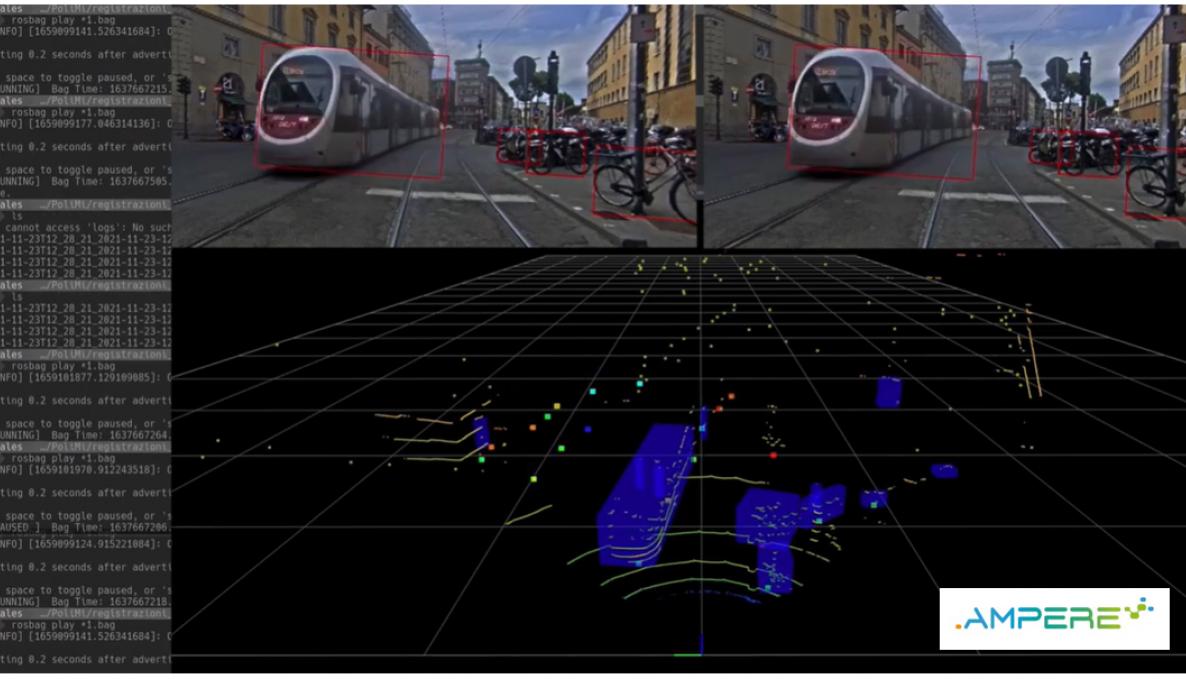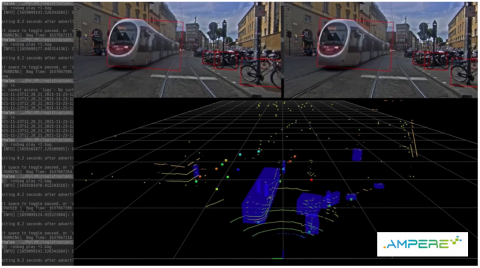AMPERE: a novel platform to design embedded high-performance systems. Achieved a 30% cost reduction in software development in automotive and railway use-cases

The AMPERE Project (A Model-driven development framework for highly Parallel and EneRgy-Efficient computation supporting multi-criteria optimisation), supported by the European Commission with almost 5M EUR funding, is celebrating its successful completion after 3.5 years of research, in which the RETIS Lab (Real-Time Systems Laboratory) of the TeCIP Institute (Telecommunications, Computer Engineering, and Photonics Institute) of Sant’Anna School played a key role, thanks to its expertise in operating systems and real-time systems.
The major outcome of AMPERE has been a novel platform that helps designers and developers combining and interconnecting a multitude of software and hardware heterogeneous components in a completely seamless way, so to comply by design to challenging non-functional requirements, such as timing and reliability constraints, without sacrificing energy efficiency.
The mechanisms provided by AMPERE are at the heart of the computational support for the development of embedded systems that are needed in a multitude of application domains, from smart transportation, to well-being, sustainable production and smart manufacturing. The platform leverages programming models from the high-performance computing domain, in order to deal with the computational requirements of complex cyber-physical systems in strategic domains such as the automotive and railroad ones, leading to an easier development of these systems, with a potential ~30% cost reduction in the software design and implementation lifecycle.
In AMPERE, the new platform has been applied to two remarkable use-cases from the automotive and railways domains. These were characterized by complex non-functional requirements including precise response-time constraints, high reliability levels, and energy efficiency. In the automotive domain, the Intelligent Predictive Cruise Control use-case extends the concept of adaptive cruise control, by computing the optimal speed velocity profile based on data acquired and processed in real-time about the surrounding road and traffic conditions, so to make an efficient use of fuel. The platform has also been applied in the railway domain, to realize an Obstacle Detection and Avoidance System, capable of tracking and predicting the trajectory of a multitude of moving elements in the area in front of the train in urban environments, so to support the prompt and timely reaction of drivers in case of possible collision risks.
In addition to Sant'Anna School, the AMPERE project involved academic partners with great expertise in the area of design and realization of embedded and high-performance computing systems, such as the Barcelona Supercomputing Center (coordinator of AMPERE and EU leader in the HPC domain), the ETH of Zurich, the Instituto Superior de Engenharia of Porto, and industrial partners playing a key role in the automotive and railways domains, such as Bosch, Thales Italia, Sysgo and Evidence (one of the Sant'Anna spin-off companies, recently acquired by Huawei).
"The AMPERE project provides a leap forward in the cyber-physical computing domain by enabling HPC parallel programming models to offer a faster and more reliable and resource-efficient development and deployment of systems, like rail and automotive. The applications of the AMPERE software framework could potentially revolutionize a wide array of industries that require the use of sophisticated parallel and heterogeneous computing technologies” says Eduardo Quiñones, AMPERE coordinator and Group Leader of the Predictable Parallel Computing Group at the Barcelona Supercomputing Center.
The Scuola Superiore Sant'Anna participated in the AMPERE project with a team coordinated by Tommaso Cucinotta, Associate Professor in embedded systems and cloud computing at the RETIS Lab of the TeCIP Institute. Specifically, the RETIS realized operating system mechanisms and optimal management techniques, supporting software parallelism in presence of hardware acceleration on GPU and FPGA devices, respecting tight real-time and energy efficiency requirements. The majority of the work has been published both as scientific papers and as open-source tools for the Linux operating system.
Additional information about the project is available in the attached note by the AMPERE dissemination unit, and the page summarizing key exploitable results achieved by all partners.




